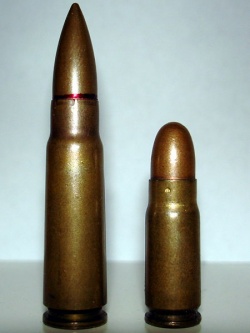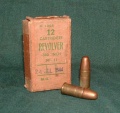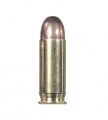Full metal jacket bullet
A full metal jacket (or FMJ) is a bullet encased in a copper alloy such as gilding metal, or cupronickel, or a steel alloy shell. This shell can extend around all of the bullet or often just the front and sides with the rear left as exposed lead. The jacket allows for higher muzzle velocities than bare lead without depositing significant amounts of metal in the bore. It also prevents damage to bores from steel or armor piercing core materials. This bullet type distinguishes itself from hollow point bullets.
Contents |
History
The first full metal jacket rifle bullet to be adopted for a military rifle was designed by a Major Rubin of the Swiss Army in 1883. Full metal jacket ammunition is acceptable for military use by the countries that signed the Hague Convention of 1899, which prohibits the use of hollow point or expanding bullets in war between the countries which signed that agreement. It is often incorrectly stated that the prohibition is part of the Geneva Conventions, and that full metal jacket bullets are specifically required.
Advantages
- Because FMJ bullets do not expand, they are more effective at piercing armor.
- They are more durable and withstand rough handling on the battlefield.
- Their rounded tips permit proper transit up the feed ramp, whereas the usage of hollow point bullets can cause failures to feed.
Disadvantages
Because FMJ bullets do not expand, they are much less likely to stop an enemy combatant. Hunters are, in some locations, not allowed to use FMJ rounds due to their perceived limited stopping power and propensity to ricochet.
Tumbling and frangible FMJ bullets
Some designs of FMJ rifle ammunition inflict more destructive gunshot wounds than others. Not all FMJ bullets contain a simple lead filling. Here are some examples:
- Although British Mark 7 .303 ammunition is compliant with the terms of the Hague Convention, it creates more destructive gunshot wounds than standard spitzer bullets due to its internal design. The centre of gravity of the Mark 7 bullet is deliberately shifted towards the rear. This is achieved by constructing the front third of the interior of the bullet from a lighter material such as aluminium or wood pulp. The result is a tail-heavy FMJ bullet which yaws violently after hitting the target.
- American 5.56mm NATO FMJ ammunition has a much thinner jacket than others. As a result the bullet may yaw and fragment by fracturing along the cannelure.
- Russian 5.45x39mm FMJ ammunition uses a tail-heavy bullet which has a tendency to yaw after hitting the target.
- German 7.62x51mm NATO FMJ uses a thin steel casing instead of copper, which results in them fracturing after penetration and causing massive tissue damage similar to a larger version of the US 5.56mm bullet.
See also
Images
External links
- Declaration (IV, 3) concerning Expanding Bullets, made at the 1899 International Peace Conference at The Hague, which entered into force on September 4, 1900
- European Ammunition Box Translations
- Photos showing terminal effects of British Mark 7 .303 bullets















